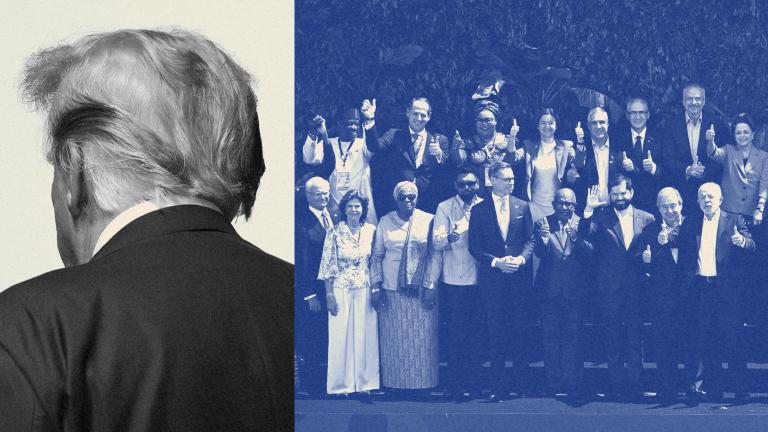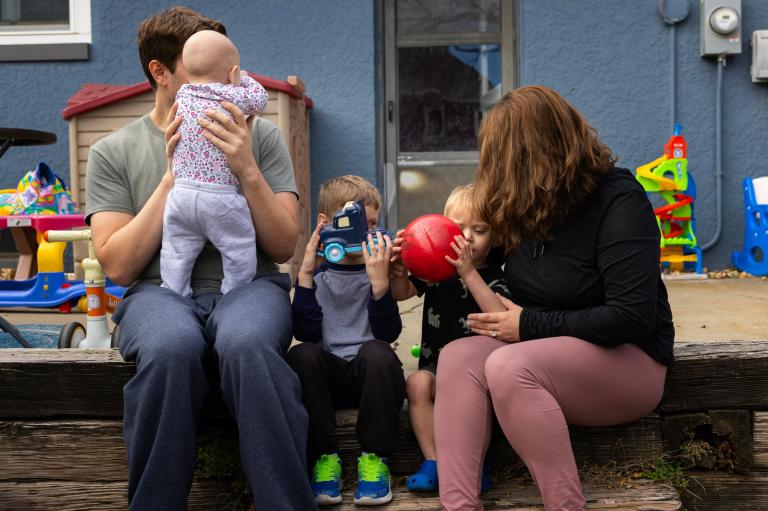“We had to build a city not for businesses or automobiles, but for children and thus for people,” said a man in a speech last year. “Instead of building highways, we restricted car use. … We invested in high-quality sidewalks, pedestrian streets, parks, bicycle paths, libraries; we got rid of thousands of cluttering commercial signs and planted trees. … All our everyday efforts have one objective: Happiness.”
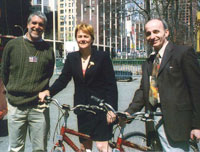
Enrique Penalosa (on left).
Photo: Institute for Transportation and
Development Policy.
Did the voters of Boulder, Colo. write in the Dalai Lama as their mayor? Had George Harrison turned to city planning in the last year of his life? Nope. This speech was given in Jakarta, Indonesia, by Enrique Penalosa, the former mayor of Bogota, Colombia. Yep, that’s the Bogota you were warned not to visit because you might be kidnapped or murdered. It’s the Bogota of the 38-year-old civil war, the highly dubious War on Drugs, the corrupt politics, the paralyzing traffic jams, the choking smog. But it is also the Bogota that, for seven years, has been under the guidance of two highly unusual mayors, Penalosa and Antanus Mockus, who have helped make this city of 8 million a model of progressive urban development.
Mockus, a former mathematics professor known for such antics as hiring mimes to model civil behavior in the streets, was mayor from 1995 to 1998. As his successor from 1998 to 2001, Penalosa masterminded a new bus system and designed a network of bike paths that is the envy of Portland, Ore. Mockus was elected again last year — after staging a ceremony in a public fountain to ask forgiveness for leaving the mayor’s office in an unsuccessful bid for the presidency. Unconventional, no doubt about it, but in Colombia’s capital city, that’s par for the course.
Against the Odds …
To understand just how unusual politics-as-usual are in Bogota, it helps to grasp the big picture. First there is Colombia, a nation plagued by a 20 percent unemployment rate, widespread destitution (55 percent of Colombians live below the poverty line), declining exports (if you don’t count illegal drugs), and, to put it nicely, political instability. The nation’s environment is threatened by the usual litany of woes, most prominently deforestation, pesticide use, and air pollution — particularly in the capital city.
Then there is the condition of Latin American cities in general. Widespread urbanization in the region has lead to a proliferation of slums, many of which lack basic services. Because the growth is generally unplanned, urban areas suffer from inadequate means of disposing of wastewater, severe groundwater pollution, and water shortages. Air pollution is a serious concern, with many of the region’s largest cities — Mexico City, Santiago, Sao Paulo — suffering from some of the worst smog in the world. Lead emissions, primarily from leaded gasoline but also from industrial pollution, are also a significant problem.
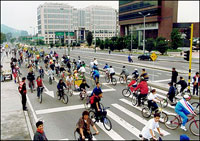
Bicyling beautiful Bogota.
Photo: Institute for Transportation and
Development Policy.
This is the grim context in which Penalosa and Mockus rose to political prominence. Penalosa inherited his interest in urban issues from his father, a one-time Bogota City Council member and housing specialist for the United Nations. When Penalosa fils took office, he launched a near-obsessive crusade to reform the city’s transportation system. Penalosa declared a virtual War on Cars, restricting traffic during peak hours to reduce rush hour traffic by 40 percent and convincing the City Council to increase the tax on gasoline. Half of the revenues generated by the increase were then poured into a bus system that currently serves 500,000 Bogota residents every day.
“Every Sunday, we close 120 kilometers of main arteries to motor vehicles for seven hours,” Penalosa explained. “A million and a half people of all ages and conditions come out to ride bicycles, jog, see others, to appropriate their city. During Christmas, we close those streets one night and more than 3 million people come out just to see the Christmas lights, to be with the others as a community.”
… In the Oddest Ways
While Penalosa has been credited with the vision, Mockus won much of the citizenry over with sheer wackiness. During his first term, he strolled the streets in red and blue tights as a “Super Citizen,” giving tips on civility. He starred in a televised public service announcement to promote water conservation — while in the shower. He ran his last campaign on a platform composed almost entirely of traffic issues, has exhorted city residents to “arm themselves with love,” and has been credited with doing away with corrupt police officers.
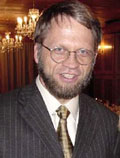
Bogota Mayor Antanus
Mockus.
Photo: Sierra James.
The means might be goofy, but the ends are undeniably impressive. According to the New York Times, Bogota is now statistically safer than Caracas and Rio de Janiero — not to mention Washington, D.C., and Baltimore. In 2000, Penalosa was honored with the Stockholm Challenge Award for creating Bogota’s car-free day — the largest and most successful event of its kind in the world. The award focused significant international attention on Bogota and caused the United Nations, in partnership with a variety of organizations including Earth Day Network, to organize a workshop in Bogota for other mayors interested in creating car-free days in their cities.
Less than a decade ago, Penalosa told Grist, Bogota was a city “hated by its inhabitants, who felt powerless and felt that in the future things would only get worse.” Conditions could hardly be more different now, and the former mayor says much of the change is thanks to the way alternative transportation has transformed the city’s public spaces. Nowadays, Penalosa said, the people of Bogota “have a sense of belonging. They feel in control of their destiny.”

